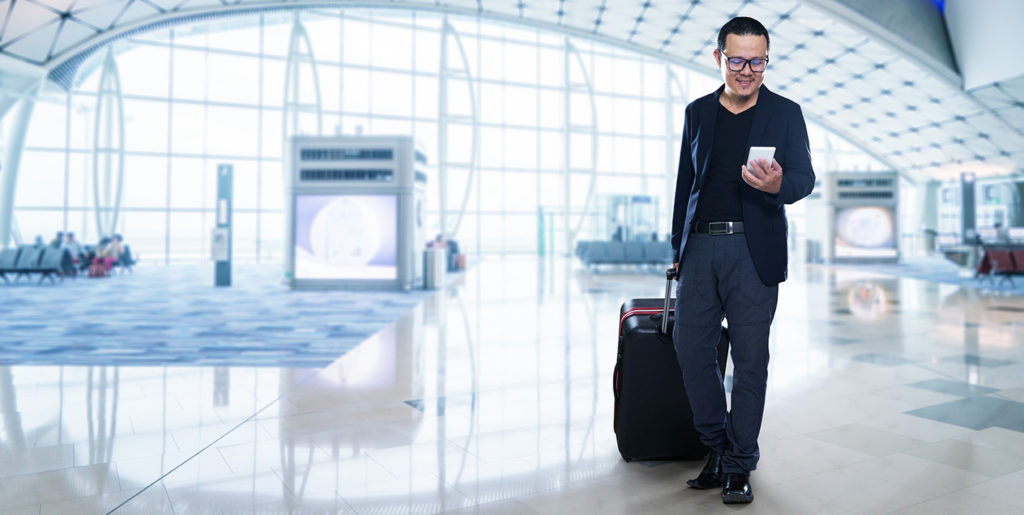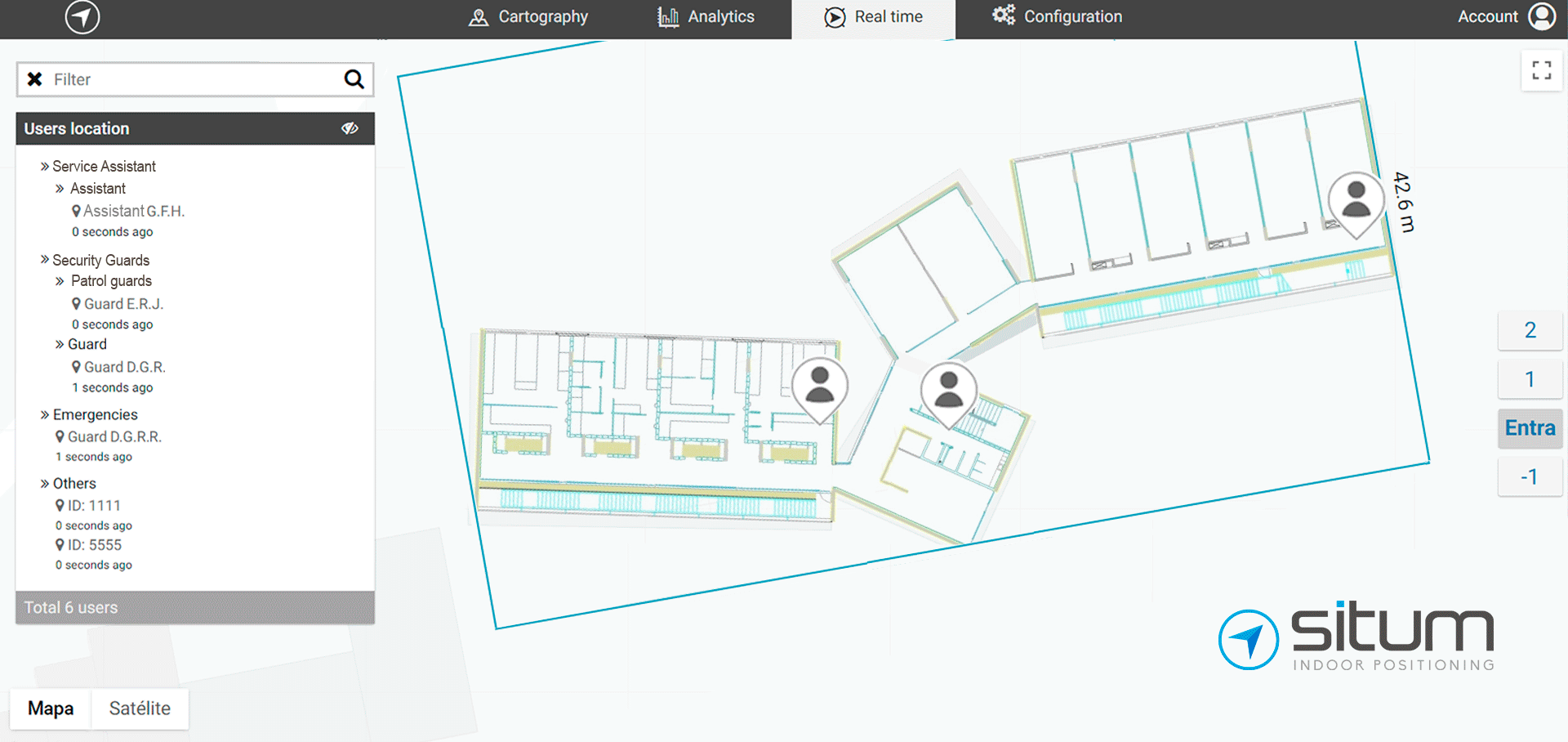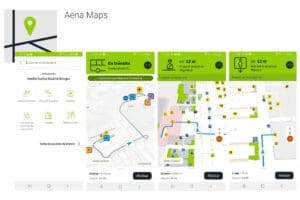Whether it is wayfinding through indoor navigation for passengers or employee indoor tracking, indoor positioning for airports is already changing the passengers’ experience, the workers’ productivity and airport planning worldwide.
Who has not felt a bit anxious when heading to the boarding gate at an airport they have never been to before, not being sure if they are walking in the right direction and if they will arrive on time? Who has not experienced the frustration of feeling disoriented despite having followed all the signs?
Airports are becoming larger and more complex, and passengers have to walk long distances. In addition, the myriad of signs often does not fulfil their objectives of making it easy for travellers to find their way. Billboards increase the number of visual stimuli and distract the visitor.
For some years, there have been apps that provide the route to the destination by manually indicating the starting point. But what if you do not know where you are? Outdoors there is no problem because GPS detects our location and draws the route without requiring us to do anything more than just indicate our destination. But indoors it is different, because GPS does not work, and the alternatives are inaccurate or very expensive because of the infrastructure required.
Indoor positioning technologies for airports
The more successful alternatives for indoor navigation and guidance at airports that are being implemented are solutions based on using Wi-Fi or Bluetooth signal processing.Their main advantage lies in the fact that they use signals from infrastructures already installed in airports, mainly Bluetooth beacons, which considerably reduces the need for additional ones. Bluetooth beacons provide low energy Bluetooth signals (BLE) and are essential when you want to provide indoor location services to iPhones, since iOS does not allow automatic scanning of Wi-Fi networks.
Among the solutions available in the market, Situm’s is characterized by providing high precision (less than 5 metres, more than enough to guide a passenger through the corridors of any airport) requiring few beacons. Situm’s indoor positioning core technology is a robust algorithm that combines Wi-Fi, BLE and magnetic field signals with the data provided by smartphone’ inertial sensors (compass, gyroscope and accelerometer).

Wayfinding for indoor navigation at airports
Therefore, a user of an app that integrates Situm’s wayfinding functionality can easily navigate to their destination without having to do anything more than indicate where they want to go.
Indoor positioning and indoor navigation for airports are especially useful solutions for people with reduced mobility, since the system enables users to define specific routes, avoiding steep stairs or ramps. To make transit easier for visually impaired people, voice guidance can also be provided. Voice guidance (as well as on-screen contents) can be provided in different languages.

But in addition to helping passengers get to their destination, indoor navigation helps monetize their transit. Promotional actions based on geofencing can be carried out once we know the visitor’s location. There is no better situation to motivate a traveller to enter our stores than to impress them with an exclusive promotion just when they are passing close by.
Airports can also earn additional revenue from better marketing of advertising spaces in their apps because of increased usage. It has been observed in some of Situm’s deployments that the usage of an app can be increased by 50% in the first month after adding indoor navigation.
Another advantage of this system based on indoor location is the availability of analytics with relevant data, such as passenger density by areas or duration of visits. With this information, the airport manager can plan spaces better based on the flow of visitors, or assign staff more efficiently depending on foreseeable peaks of passenger number based on the analysis of historical data.
One might think that improving service to passengers and obtaining relevant information is all that can be achieved by deploying indoor positioning technology at an airport.
Nothing could be further from the truth.
Indoor tracking for handling services management through geolocation

Thousands of workers maintain the airport and provide different services to its users: police, security guards, cleaning staff, personnel that assist people with reduced mobility, ground crew, waiters, maintenance operators, etc… Like indoor positioning and indoor navigation, tracking workers and monitoring their activity has become an essential tool to improve services and optimize processes. Situm’s indoor positioning system especially facilitates the monitoring of employees while they work, as mobile phones can be tracked with precision even inside a pocket.

Situm MRM is the ready-to-use platform to manage staff and mobile resources by geolocation. It helps to improve customer services and achieve greater control, and the optimization and auditing of processes through different functionalities:
- Real-time visualization of all tracked devices indoors and outdoors.
- Analytics with location density and visit durations.
- Historical record of routes.
- Definition of worker’s roles and their assignment to devices, buildings or spaces.
- Authorization or prohibition of access to different areas.
- Automatic geolocated notifications to remind tasks when entering a certain area.
Worker safety is another field in which Situm can provide improvements, facilitating a quick reaction to unforeseen events through different alarms.
- The “Panic button” sets off an alert notifying the position by a simple movement of the mobile or by pressing a key.
- The “Man-down alert” automatically notifies when a person has fallen, either due to an accident or by fainting.
Whether by wayfinding or tracking, the fact is that indoor positioning is already changing passengers’ experiences, workers’ productivity and airport planning worldwide.
Airport indoor navigation and handling service management success cases
Our experience working with airports covers all the use cases mentioned above: from indoor navigation for passengers to employee monitoring in order to improve security or handling services.

As for passenger indoor navigation, we are the indoor geolocation technology used for the development of Aena Maps. This solution has been developed by one of the largest airport operators in the world and implemented in airports of international stature such as Madrid and Barcelona. Through this app, travellers receive step-by-step directions on their smartphone from the door of their home to the boarding gate they need to reach, covering all the intermediate points along the way: security control, duty-free, services, restaurants, etc.
Aena Maps, developed together with Aena and in collaboration with Telefónica and CARTO, has already been successfully expanded to other airports such as Alicante, Malaga and Mallorca.

In terms of employee monitoring solutions, the one developed together with Ferrovial Services to improve their handling services helps detect potentially conflictive points (due to high occupancy or the presence of security, restricted areas, etc.), optimise the route that workers follow to attend to their tasks or assist passengers, reduce the time it takes to prepare operations and, overall, optimise available resources.

And finally, I-SEC has also implemented indoor location technology to manage its security staff at Adolfo Suárez-Madrid Barajas airport. This makes it the first airport to have two different solutions powered by Situm: passenger guidance with Aena and security services management with I-SEC. Our platform has become their number one resource to manage their patrols and related tasks, security alarms and efficiency through personalized analytics and reports.
For more information about how to optimize your processes and improve your services, do not hesitate to contact us.
You also can try Situm IPS platform for free.
